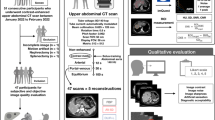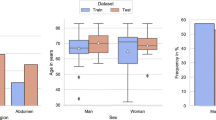Abstract
Purpose
To develop and assess the utility of synthetic dual-energy CT (sDECT) images generated from single-energy CT (SECT) using two state-of-the-art generative adversarial network (GAN) architectures for artificial intelligence-based image translation.
Methods
In this retrospective study, 734 patients (389F; 62.8 years ± 14.9) who underwent enhanced DECT of the chest, abdomen, and pelvis between January 2018 and June 2019 were included. Using 70-keV as the input images (n = 141,009) and 50-keV, iodine, and virtual unenhanced (VUE) images as outputs, separate models were trained using Pix2PixHD and CycleGAN. Model performance on the test set (n = 17,839) was evaluated using mean squared error, structural similarity index, and peak signal-to-noise ratio. To objectively test the utility of these models, synthetic iodine material density and 50-keV images were generated from SECT images of 16 patients with gastrointestinal bleeding performed at another institution. The conspicuity of gastrointestinal bleeding using sDECT was compared to portal venous phase SECT. Synthetic VUE images were generated from 37 patients who underwent a CT urogram at another institution and model performance was compared to true unenhanced images.
Results
sDECT from both Pix2PixHD and CycleGAN were qualitatively indistinguishable from true DECT by a board-certified radiologist (avg accuracy 64.5%). Pix2PixHD had better quantitative performance compared to CycleGAN (e.g., structural similarity index for iodine: 87% vs. 46%, p-value < 0.001). sDECT using Pix2PixHD showed increased bleeding conspicuity for gastrointestinal bleeding and better removal of iodine on synthetic VUE compared to CycleGAN.
Conclusions
sDECT from SECT using Pix2PixHD may afford some of the advantages of DECT.








Similar content being viewed by others
References
Marin D, Boll DT, Mileto A, Nelson RC. State of the art: dual-energy CT of the abdomen. Radiology. 2014;271(2):327-42.
Patino M, Prochowski A, Agrawal MD, Simeone FJ, Gupta R, Hahn PF, et al. Material separation using dual-energy CT: current and emerging applications. Radiographics. 2016;36(4):1087-105.
Shuman WP, Green DE, Busey JM, Mitsumori LM, Choi E, Koprowicz KM, et al. Dual-energy liver CT: effect of monochromatic imaging on lesion detection, conspicuity, and contrast-to-noise ratio of hypervascular lesions on late arterial phase. American Journal of Roentgenology. 2014;203(3):601-6.
Noda Y, Tochigi T, Parakh A, Joseph E, Hahn PF, Kambadakone A. Low keV portal venous phase as a surrogate for pancreatic phase in a pancreatic protocol dual-energy CT: feasibility, image quality, and lesion conspicuity. European Radiology. 2021:1-11.
McNamara MM, Little MD, Alexander LF, Van Carroll L, Beasley TM, Morgan DE. Multireader evaluation of lesion conspicuity in small pancreatic adenocarcinomas: complimentary value of iodine material density and low keV simulated monoenergetic images using multiphasic rapid kVp-switching dual energy CT. Abdominal imaging. 2015;40(5):1230-40.
Schabel C, Patel B, Harring S, Duvnjak P, Ramírez-Giraldo JC, Nikolaou K, et al. Renal lesion characterization with spectral CT: determining the optimal energy for virtual monoenergetic reconstruction. Radiology. 2018;287(3):874-83.
Mileto A, Nelson RC, Marin D, Roy Choudhury K, Ho LM. Dual-energy multidetector CT for the characterization of incidental adrenal nodules: diagnostic performance of contrast-enhanced material density analysis. Radiology. 2015;274(2):445-54.
Kim YK, Park BK, Kim CK, Park SY. Adenoma characterization: adrenal protocol with dual-energy CT. Radiology. 2013;267(1):155-63.
Wortman JR, Shyu JY, Dileo J, Uyeda JW, Sodickson AD. Dual-energy CT for routine imaging of the abdomen and pelvis: radiation dose and image quality. Emergency radiology. 2020;27(1):45-50.
Yu L, Leng S, McCollough CH. Dual-energy CT–based monochromatic imaging. American journal of Roentgenology. 2012;199(5_supplement):S9-S15.
Yue D, Fan Rong C, Ning C, Liang H, Ai Lian L, Ru Xin W, et al. Reduction of metal artifacts from unilateral hip arthroplasty on dual-energy CT with metal artifact reduction software. Acta Radiologica. 2018;59(7):853-60.
Agrawal MD, Pinho DF, Kulkarni NM, Hahn PF, Guimaraes AR, Sahani DV. Oncologic applications of dual-energy CT in the abdomen. Radiographics. 2014;34(3):589-612.
Machida H, Tanaka I, Fukui R, Shen Y, Ishikawa T, Tate E, et al. Dual-energy spectral CT: various clinical vascular applications. Radiographics. 2016;36(4):1215-32.
Patel BN, Boltyenkov AT, Martinez MG, Mastrodicasa D, Marin D, Jeffrey RB, et al. Cost-effectiveness of dual-energy CT versus multiphasic single-energy CT and MRI for characterization of incidental indeterminate renal lesions. Abdominal Radiology. 2020;45(6):1896-906.
Patel BN, Rosenberg M, Vernuccio F, Ramirez-Giraldo JC, Nelson R, Farjat A, et al. Characterization of small incidental indeterminate hypoattenuating hepatic lesions: added value of single-phase contrast-enhanced dual-energy CT material attenuation analysis. American Journal of Roentgenology. 2018;211(3):571-9.
Megibow AJ. Clinical abdominal dual-energy CT: 15 years later. Abdominal Radiology. 2020;45(4):1198-201.
Patel BN, Alexander L, Allen B, Berland L, Borhani A, Mileto A, et al. Dual-energy CT workflow: multi-institutional consensus on standardization of abdominopelvic MDCT protocols. Abdominal Radiology. 2017;42(3):676-87.
Isola P, Zhu J-Y, Zhou T, Efros AA, editors. Image-to-image translation with conditional adversarial networks. Proceedings of the IEEE conference on computer vision and pattern recognition; 2017.
Zhu J-Y, Park T, Isola P, Efros AA, editors. Unpaired image-to-image translation using cycle-consistent adversarial networks. Proceedings of the IEEE international conference on computer vision; 2017.
Mirza M, Osindero S. Conditional generative adversarial nets. arXiv preprint arXiv:14111784. 2014.
Wolterink JM, Dinkla AM, Savenije MH, Seevinck PR, van den Berg CA, Išgum I, editors. Deep MR to CT synthesis using unpaired data. International workshop on simulation and synthesis in medical imaging; 2017: Springer.
Seitzer M, Yang G, Schlemper J, Oktay O, Würfl T, Christlein V, et al., editors. Adversarial and perceptual refinement for compressed sensing MRI reconstruction. International conference on medical image computing and computer-assisted intervention; 2018: Springer.
Armanious K, Jiang C, Fischer M, Küstner T, Hepp T, Nikolaou K, et al. MedGAN: Medical image translation using GANs. Computerized Medical Imaging and Graphics. 2020;79:101684.
Liu Y, Chen A, Shi H, Huang S, Zheng W, Liu Z, et al. CT synthesis from MRI using multi-cycle GAN for head-and-neck radiation therapy. Computerized Medical Imaging and Graphics. 2021;91:101953.
Nie D, Trullo R, Lian J, Wang L, Petitjean C, Ruan S, et al. Medical image synthesis with deep convolutional adversarial networks. IEEE Transactions on Biomedical Engineering. 2018;65(12):2720-30.
Chartsias A, Joyce T, Dharmakumar R, Tsaftaris SA, editors. Adversarial image synthesis for unpaired multi-modal cardiac data. International workshop on simulation and synthesis in medical imaging; 2017: Springer.
Wang T-C, Liu M-Y, Zhu J-Y, Tao A, Kautz J, Catanzaro B, editors. High-resolution image synthesis and semantic manipulation with conditional gans. Proceedings of the IEEE conference on computer vision and pattern recognition; 2018.
Tamm EP, Le O, Liu X, Layman RR, Cody DD, Bhosale PR. “How to” incorporate dual-energy imaging into a high volume abdominal imaging practice. Abdominal radiology. 2017;42(3):688-701.
Mileto A, Ananthakrishnan L, Morgan DE, Yeh BM, Marin D, Kambadakone AR. Clinical implementation of dual-energy CT for gastrointestinal imaging. American Journal of Roentgenology. 2021;217(3):651-63.
Marin D, Davis D, Roy Choudhury K, Patel B, Gupta RT, Mileto A, et al. Characterization of small focal renal lesions: diagnostic accuracy with single-phase contrast-enhanced dual-energy CT with material attenuation analysis compared with conventional attenuation measurements. Radiology. 2017;284(3):737-47.
Kaza RK, Caoili EM, Cohan RH, Platt JF. Distinguishing enhancing from nonenhancing renal lesions with fast kilovoltage-switching dual-energy CT. American Journal of Roentgenology. 2011;197(6):1375-81.
Patel BN, Vernuccio F, Meyer M, Godwin B, Rosenberg M, Rudnick N, et al. Dual-energy CT material density iodine quantification for distinguishing vascular from nonvascular renal lesions: normalization reduces intermanufacturer threshold variability. American Journal of Roentgenology. 2019;212(2):366-76.
Bellini D, Panvini N, Laghi A, Marin D, Patel BN, Wang CL, et al. Systematic review and meta-analysis investigating the diagnostic yield of dual-energy CT for renal mass assessment. American Journal of Roentgenology. 2019;212(5):1044-53.
Patel BN, Alexander L, Allen B, Berland L, Borhani A, Mileto A, Moreno C, Morgan D, Sahani D, Shuman W, Tamm E, Tublin M, Yeh B, Marin D. Dual-energy CT workflow: multi-institutional consensus on standardization of abdominopelvic MDCT protocols. Abdom Radiol (NY). 2017 Mar;42(3):676-687. doi: https://doi.org/10.1007/s00261-016-0966-6. PMID: 27888303.
Kerfoot E, Puyol-Antón E, Ruijsink B, Ariga R, Zacur E, Lamata P, et al. Synthesising images and labels between MR sequence types with CycleGAN. Domain Adaptation and Representation Transfer and Medical Image Learning with Less Labels and Imperfect Data: Springer; 2019. p. 45-53.
Borhani AA, Kulzer M, Iranpour N, Ghodadra A, Sparrow M, Furlan A, et al. Comparison of true unenhanced and virtual unenhanced (VUE) attenuation values in abdominopelvic single-source rapid kilovoltage-switching spectral CT. Abdominal radiology. 2017;42(3):710-7.
Xiao JM, Hippe DS, Zecevic M, Zamora DA, Cai LM, Toia GV, et al. Virtual Unenhanced Dual-Energy CT Images Obtained with a Multimaterial Decomposition Algorithm: Diagnostic Value for Renal Mass and Urinary Stone Evaluation. Radiology. 2021;298(3):611-9.
Meyer M, Nelson RC, Vernuccio F, González F, Farjat AE, Patel BN, et al. Virtual unenhanced images at dual-energy CT: influence on renal lesion characterization. Radiology. 2019;291(2):381-90.
Durieux P, Gevenois PA, Muylem AV, Howarth N, Keyzer C. Abdominal attenuation values on virtual and true unenhanced images obtained with third-generation dual-source dual-energy CT. American Journal of Roentgenology. 2018;210(5):1042-58.
Acknowledgements
None.
Funding
None specifically for this study.
Author information
Authors and Affiliations
Corresponding author
Ethics declarations
Competing interests
ASW is supported by GE Healthcare, Siemens Healthineers, and NIH R21EB030080. DM: Activities related to the present article: none. Activities not related to the present article: research Grant from the National Institute of Biomedical Imaging and Bioengineering (5T32EB009035). Shareholder of Segmed, Inc. Consultant for Segmed, Inc. Other relationships: no relevant relationships.
Additional information
Publisher's Note
Springer Nature remains neutral with regard to jurisdictional claims in published maps and institutional affiliations.
Rights and permissions
Springer Nature or its licensor (e.g. a society or other partner) holds exclusive rights to this article under a publishing agreement with the author(s) or other rightsholder(s); author self-archiving of the accepted manuscript version of this article is solely governed by the terms of such publishing agreement and applicable law.
About this article
Cite this article
Jeong, J., Wentland, A., Mastrodicasa, D. et al. Synthetic dual-energy CT reconstruction from single-energy CT Using artificial intelligence. Abdom Radiol 48, 3537–3549 (2023). https://doi.org/10.1007/s00261-023-04004-x
Received:
Revised:
Accepted:
Published:
Issue Date:
DOI: https://doi.org/10.1007/s00261-023-04004-x




